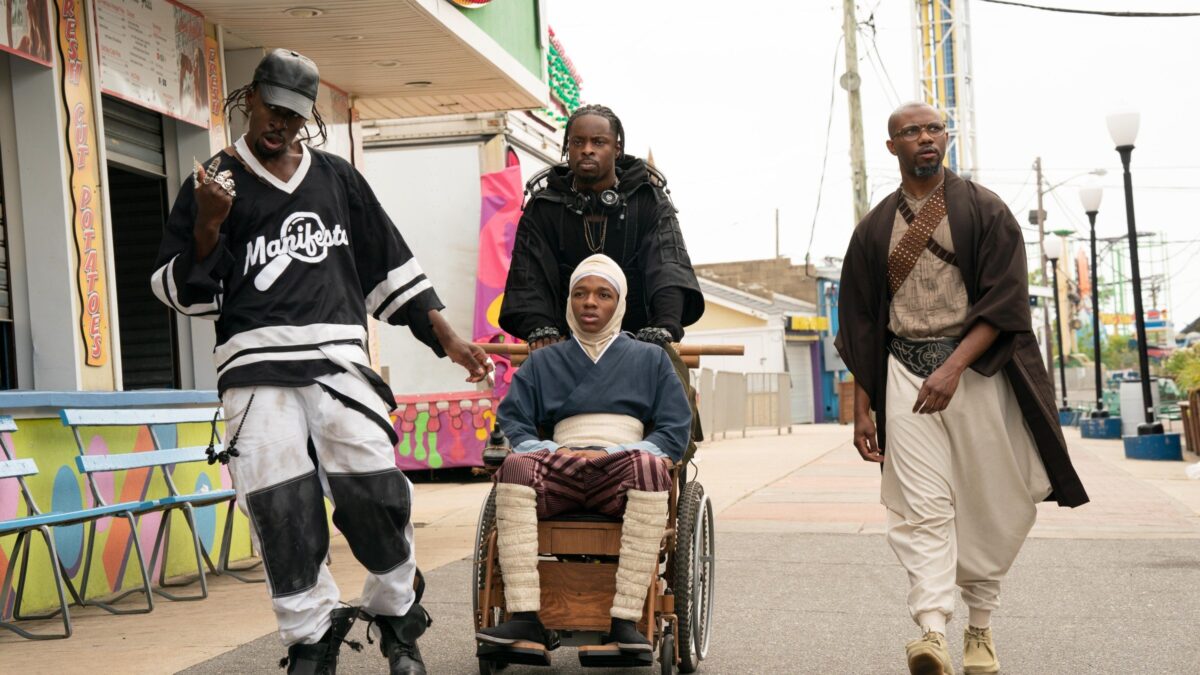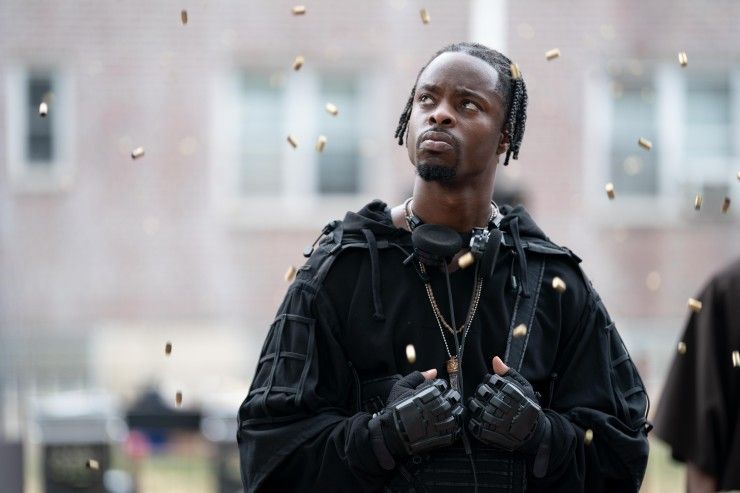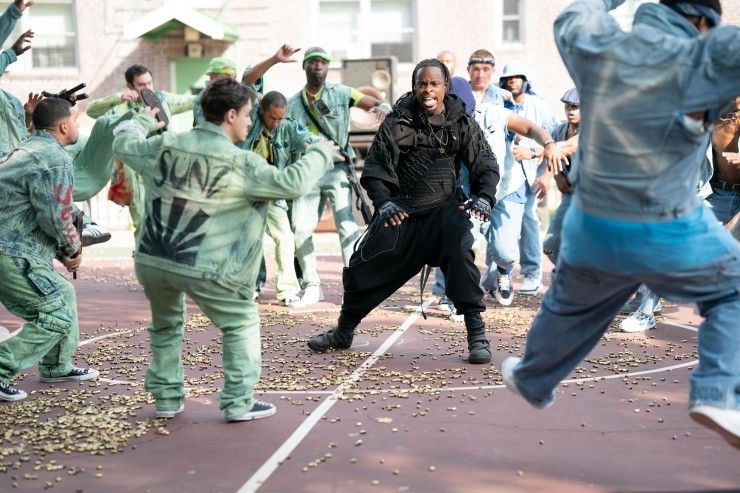
Wu-Tang Clan ain’t nothing to f*** with.
This post was written by Marc Wiltshire.
The snow was polar white in the Montreal winter of 1994. I was eleven years old, sitting on the school bus when a kid hands the driver a mixtape. What I heard next would turn my freezing butt on fire: Wu-Tang Clan’s Ain’t Nothin’ To F**k With! I knew instantly that what I was hearing was special.
I also recognized that my mother would disapprove of me listening to it. Too late. I became hooked on the sounds coming from a faraway land named Shaolin.
Cut to thirty years later when I landed my dream job editing the third and final season of Wu-Tang: An American Saga, a biopic TV show co-created by Wu-Tang founding member RZA about the rise of one of the most popular musical groups in history.
How does one live up to the vision and hype of a celebrated TV series based on real people? You do your homework.
Exploring Shaolin
Before starting work on the final season, I consumed all the Wu-Tang content I could find.
I studied the series, taking note of all the editing techniques they employed. I read both of RZA’s books, The Wu-Tang Manual and The Tao of Wu. I watched Showtime’s immersive four-part documentary, Wu-Tang Clan: Of Mics and Men. Finally, I scoured the web for articles, interviews, music videos, and anything that would help me understand these very different artists and how they came together to form a “Voltron” supergroup.
The first two seasons of Wu-Tang: An American Saga follow the development of the group as they figured out their sound and struggle to survive in the streets of New York City. What set Season 3 apart are the allegorical “films” that capture the creative process and spiritual essence of the group and their music.

This shift drastically changed the tone, conflict, and stakes from previous seasons. One of my challenges as an editor was maintaining the show’s DNA while elevating the story and characters into this new world.
Unlike many TV shows, there was no cookie-cutter format to draw from. The scripts were rich and detailed in their storytelling, without dictating how it should look or feel. It was both liberating and terrifying.
Digging Through the Pop Culture Crates
The soul of the series is Hip-Hop, so sampling played a pivotal role in how we approached the editing. While many musical biopics can turn into a visual Wikipedia entry, Wu-Tang: An American Saga thrives by excavating the bones the music is built from, boldly showcasing its influences and at times telling the story through a fantastical lens rather than being grounded in reality.
Liquid Swords (episode 308) is the first-ever episode written & directed by series co-creator and founding Wu-Tang member, RZA. An allegorical “film” that pays homage to Hip-Hop culture via a pastiche of influences ranging from Akira Kurosawa to 90’s Music Videos, as well as a variety of films including The Wizard of Oz, Star Wars, Shogun Assassin, Mad Max, The Warriors, West Side Story, and classic Kung Fu movies. Every scene in this episode references a different movie or genre, so the editing style changed from scene to scene.
I approached each episode by first breaking down the script, underlining dialogue or scene descriptions that referenced pop culture or an important event that occurred around the time the story takes place. We were encouraged to make bold choices in the editing.
My brilliant assistant editor, Alex Wills, and I experimented with sound effects and music placements that would connect the audience to the ideas laid out in the script. We sampled sounds from movies and even created new ones, weaving a tapestry of references into our narrative.
In the Liquid Swords episode, I managed to sprinkle in a lot of sound elements that were inspired by the movies we were paying homage to. I recall our sound designer pleading with us not to use the Wilhelm Scream that I had slotted in the edit during a musical battle scene, but RZA told us to keep it in, and I’m forever grateful.

Editing Music Videos Within a Narrative Story
The series had the added challenge of incorporating musical performances. The Liquid Swords episode alone contains five music videos within the larger story. Those are messier and are assembled less linearly than traditional dialogue scenes, requiring a different approach in the editorial.
The final battle sequence is a recreation of the music video for GZA 4th Chamber. You could watch them side by side, and they’d line up pretty closely. That was a trip to edit because I had to capture the essence of that music video, with its kinetic cuts and non-linear structure, while keeping the story on track.
We had a ton of battle footage to sort through, so we did several passes on that sequence due to the sheer amount of possibilities. I got to make a huge mess of the footage, editing from my gut rather than being surgical. It was wild, liberating, and the most fun I’ve ever had editing.

Editing is Exactly Like a Samurai’s Journey
OK, maybe this is a stretch, but we do tend to work alone a lot of the time. Often, we run into seemingly insurmountable challenges along the way. I watched a lot of samurai movies to prepare for Liquid Swords, and, after a while, I related to chopping heads off to protect the village.
Our duty as editors is to ensure we’re protecting the story at all costs, and sometimes this means cutting a scene or an entire plot point if that elevates the overall story we’re telling.
RZA had a lot of ideas he wanted to express through this film, and a few of those ideas had to go in order to keep our story on track. RZA is a fantastic collaborator, always willing to try anything if it means telling a better story. Sometimes we would cut out a moment or a line of dialogue, and it worked. Other times, we would cut an entire chunk, only to decide several cuts later to bring it all back.

My favorite instance of this was when we were getting a repeated note to trim down a particularly long scene that consisted of a monologue. We trimmed it down several times, and ultimately RZA requested that we revert it back to the original uncut version.
Crafting a film or TV show is a delicate balancing act, and sometimes you need to go down a rabbit hole to discover the best way to present an idea. Recognizing when a scene needs to breathe and play in silence or when it’s better served with a kinetic MTV style of cutting is how we sculpt the stone into a polished piece.
Editors also need to know when to let go. After the initial Editor’s Cut, it’s no longer ours, and we must be capable of honoring someone else’s vision while protecting the integrity of the cut.
I am immensely proud to have been a part of shaping this final season and have a profound respect for all the artisans that collaborated in making it.
What is your dream project, and how would you approach it?
Let me know in the comments!














